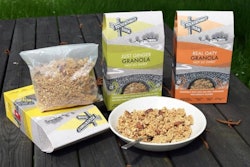Welcome to Sustainable Packaging Explained — your guide to sustainable materials, methods, and package design, produced by the Emerging Brands Alliance in conjunction with Packaging World.
Today, we'll explore the evolving industry of bio-based plastics - their pros, cons, and applications in the packaging industry. So, let's get started!
Instead of petroleum, bio-based plastics are derived from natural or renewable resources such as vegetable oils, sugarcane, corn, and starches like potatoes.
One advantage of bio-based plastics is that they take in carbon instead of emitting it. Another is that with the continuing development of the same functionality and properties as a petroleum-based plastic, bio-based plastics that are “drop-in” can now be recycled in the same recycling stream.
So, where can we find these sustainable solutions in action? In the fall of 2021, Frito Lay released an industrially compostable bag for its ‘Off The Eaten Path’ chip brand. And in 2022 Coca-Cola and Suntory each unveiled beverage bottle prototypes made from 100% bio-based PET.
You might remember the ill-fated compostable, bioplastic bag launched by PepsiCo’s Frito-Lay division in 2010 for its SunChips brand snack—you know, the one that caused an uproar among consumers due to its loud crinkling noise? PepsiCo was way ahead of its time, but it never gave up on creating a compostable material capable of replacing the plastic used for its single-use snack bags, and still delighting consumers.
Recently, it realized this goal in the form of an industrially compostable bag made primarily from proprietary, non-food, plant-based materials for its Off The Eaten Path chip brand. Frito-Lay partnered with Printpack to develop the bag, which earned the supplier Gold and Silver Flexible Packaging Association Awards for Sustainability and Packaging Excellence, respectively, for 2022. Rest assured, with the new bag, Printpack made crinkle reduction a priority through nifty some noise dampening features. The material used 85% PLA, or polylactic acid. It’s on the market today.
Not to be outdone were Coca-Cola and Suntory. After more than a decade of rigorous R&D work and significant investments with their respective partners, Coca-Cola and Suntory each unveiled first-of-their-kind beverage bottle prototypes made from 100% bio-based PET, or bPET. With its recently unveiled bPET bottle, Coca-Cola has moved to wood-based biochemicals to produce bio-based Monoethylene Glycol, or bMEG. Earlier iterations of the bottle had used sugarcane, a material that also could be also be used in competing markets, like food or bio-ethanol.
Then in early December, 2021, just six weeks after Coca-Cola’s announcement, Suntory revealed it had also successfully created a prototype bPET bottle, ready for commercial scale-up. The prototype was produced for the company’s Orangina brand in Europe as well as a mineral water in Japan. It uses non-food feedstock such as wood chips, avoiding competition with the food supply chain. It includes a simple process of converting biomass to aromatics, such as paraxylene, in one step by using a single pyrolysis process and catalysts.
From the food and beverage sector to cosmetics and personal care products, many innovations are being made with bio-based plastics. NatureFlex cellulose from Futamura is designed to be a direct replacement for fossil-based plastics and can be safely recycled in a household composter.
In 2022 Canadian pharmaceutical brand Jones Healthcare Group announced the launch of three new blister packs made from bio-plastic, with foil-free backings to aid recycling.
Bio-based plastics do face some challenges, such as cost, the ability to run on existing packaging machinery, and the concern that using food crops for plastic production might compete with food resources.
Bioplastic packaging offers benefits such as recyclability and biodegradability, but, as always, it is best to perform a life-cycle analysis of a product to determine if bio-based packaging would be a viable option for your situation.
Thanks for watching and be sure to subscribe to our YouTube channel for more videos on packaging and scaling operations. And join us at the Emerging Brands Alliance for year-round resources to grow your brand.
























